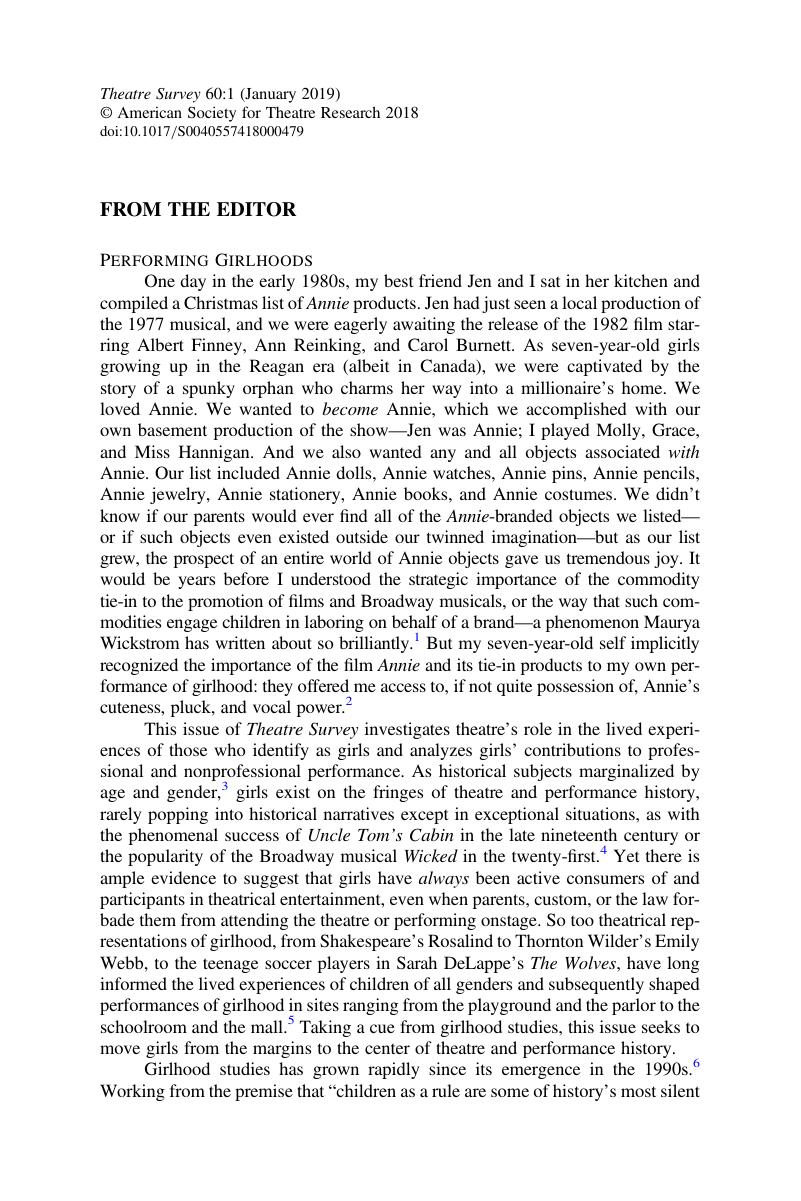No CrossRef data available.
Article contents
From the Editor
Published online by Cambridge University Press: 21 December 2018
Abstract

- Type
- From the Editor
- Information
- Copyright
- Copyright © American Society for Theatre Research 2018
References
Endnotes
1. Wickstrom, Maurya, Performing Consumers: Global Capital and Its Theatrical Seductions (New York: Routledge, 2006)CrossRefGoogle Scholar; Wickstrom, “Commodities, Mimesis and The Lion King: Retail Theatre for the 1990s,” Theatre Journal 51.3 (1999): 285–98CrossRefGoogle Scholar.
2. On the commodity tie-in or tie-up, see Allen, Jeanne, “The Film Viewer as Consumer,” Quarterly Review of Film Studies 5.4 (1980): 481–99CrossRefGoogle Scholar; Doane, Mary Anne, “The Economy of Desire: The Commodity Form in/of the Cinema,” Quarterly Review of Film & Video 11.1 (1989): 23–33CrossRefGoogle Scholar; Mayne, Judith, “Immigrants and Spectators,” Wide Angle 5.2 (1982): 32–41Google Scholar; Gaines, Jane, “The Queen Christina Tie-Ups: Convergence of Show Window and Screen,” Quarterly Review of Film & Video 11.1 (1989): 35–60CrossRefGoogle Scholar; Eckert, Charles, “The Carole Lombard in Macy's Window” (1978), repr. in Fabrications: Costume and the Female Body, ed. Gaines, Jane and Herzog, Charlotte (New York: Routledge, 1990), 100–21Google Scholar; Herzog, Charlotte Cornelia and Gaines, Jane Marie, “‘Puffed Sleeves before Tea-Time’: Joan Crawford, Adrian and Woman Audiences,” Wide Angle 6.4 (1985): 24–33Google Scholar.
3. Girlhood: A Global History, ed. Helgren, Jennifer and Vasconcellos, Colleen A. (New Brunswick, NJ, and London: Rutgers University Press, 2010), 4Google Scholar.
4. On childhood and Uncle Tom's Cabin, see Bernstein, Robin, Racial Innocence: Performing American Childhood from Slavery to Civil Rights (New York: New York University Press, 2011), 13–16Google Scholar, 92–145. On Wicked and female fans, see Wolf, Stacy, “Wicked Divas, Musical Theater, and Internet Girl Fans,” Camera Obscura 22.2 (65) (2007): 39–71CrossRefGoogle Scholar.
5. For a recent overview of plays for and/or about teenage girls, see Helen Schultz, “Teenage Girls on Stage: Young Women Who Do Things,” HowlRound, 13 October 2017, http://howlround.com/teenage-girls-on-stage-young-women-who-do-things, accessed 8 September 2018.
6. On girlhood studies see Driscoll, Catherine, Girls: Feminine Adolescence in Popular Culture and Cultural Theory (New York: Columbia University Press, 2002)Google Scholar; Helgren and Vasconcellos. On girlhood studies and performance see Warren-Crow, Heather, Girlhood and the Plastic Image (Hanover, NH: Dartmouth College Press [Lebanon, NH: UPNE], 2014)Google Scholar; Hatch, Kristen, Shirley Temple: The Performance of Girlhood (New Brunswick, NJ, and London: Rutgers University Press, 2015)Google Scholar; Williams, Deanne, Shakespeare and the Performance of Girlhood (Houndmills, Basingstoke, UK: Palgrave Macmillan, 2014)CrossRefGoogle Scholar; Heather Marie Fitzsimmons Frey, “Victorian Girls and At-home Theatricals: Performing and Playing with Possible Futures” (Ph.D. diss., Centre for Drama, Theatre and Performance Studies, University of Toronto, 2015).
7. Helgren and Vasconcellos, 4.
8. Williams, 2.
9. Helgren and Vasconcellos, 3.
10. Driscoll, 2.
11. Driscoll, 2–3; also Helgren and Vasconcellos, 3.
12. Robson, Catherine, Men in Wonderland: The Lost Girlhood of the Victorian Gentleman (Princeton: Princeton University Press, 2001)Google Scholar.
13. Butler, Judith, “Performative Acts and Gender Constitution: An Essay in Phenomenology and Feminist Theory,” Theatre Journal 40.4 (1988): 519–31CrossRefGoogle Scholar, at 519.
14. Owens, Tammy C. et al. , “Towards an Interdisciplinary Field of Black Girlhood Studies,” Departures in Critical Qualitative Research 6.3 (2017): 116–32CrossRefGoogle Scholar, at 118. This article, which includes an annotated bibliography of recent scholarship, is an indispensable source for anyone interested in BGS. See also Gaunt, Kyra D., The Games Black Girls Play: Learning the Ropes from Double-Dutch to Hip-Hop (New York: New York University Press, 2006)Google Scholar; Brown, Ruth Nicole, Black Girlhood Celebration: Toward a Hip-Hop Feminist Pedagogy (New York: Peter Lang, 2009)Google Scholar; Cox, Aimee Meredith, Shapeshifters: Black Girls and the Choreography of Citizenship (Durham, NC: Duke University Press, 2015)CrossRefGoogle Scholar.




